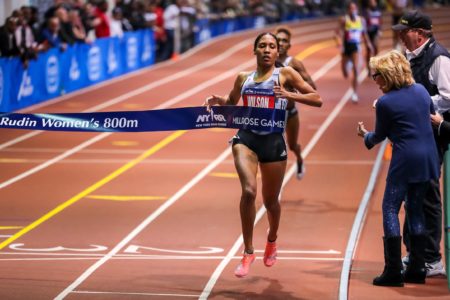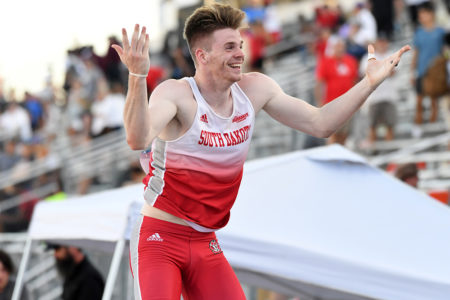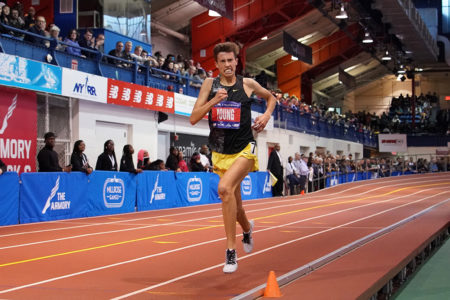
ALWAYS A CAPTIVATING SPECTACLE, a contest in which the rounds run rife with tension and those watching can expect the unforeseen, the selection of Team USA for the men’s 100 at the Olympic Trials is a competitive cauldron of rare quality. The crowd at the top this time could be—if recent history informs analysis at all—one of the toughest clubs to join in many an Olympic season for the cupboard of U.S. sprinting is stacked formidably. (links on names below lead to Preview features on each)
Justin Gatlin—winner of the last two OT races and now a nearly-unheard-of-for-sprinters 38—summed it up in Doha last fall as he and relay mates Christian Coleman, Mike Rodgers (see sidebar below) and Noah Lyles basked in the glow of collecting the first major U.S. men’s 4×1 gold since ’07. “USA sprinting, what can I say?” Gatlin asked rhetorically. “We got the 200m gold medalist, we got the 100m gold medalist right over here to my right so I think it’s in good hands so far. Me being a fan of the sport, there’s nothing more that I want to see except really good competition. And I’ve got my hands full right here in America.”
Coleman, Lyles, Gatlin and Ronnie Baker, in different orders, were the four names who put together U.S. World Rankings top 3 sweeps the past two seasons, force concentration of a very high order. The last prior Rankings 1-2-3 for the USA was way back in ’91. The last time American sprinters put together such showings in consecutive years was the 3-years-straight stretch of 1982–84. The Stateside dash is riding a high and breaking into its top echelon at this Trials—well, that won’t be easy.
By the way, add Rodgers to the echelon. Besides the aforementioned quartet, the Dallas-trained Missourian, who will be 35 by Trials time, is just one of two others who have won a USATF century crown in the last 7 seasons. The other is 37-year-old AR holder and former world champ Tyson Gay, but Rodgers placed 2nd at the Nationals in ’19 and dropped a sub-10.00 (9.97). Gay, though he was training as of last spring, hasn’t dashed faster than 10.36 since June of ’18. (Continued below)
While the best of the rest not in the Big 5 resist neat sorting into categories, let’s try these two groupings:
The Up And Comers
While high placings in past Trials or Nationals wins, proof of the pudding sprinters can set in the biggest qualifying meets with rounds, is where the analysis starts, there are always newer faces determined to join the party. “I think everybody has a shot,” says Coleman, making that case.
“I just think back to 2016. I was a sophomore in college and I always had the same mindset but I just wasn’t at the level that I am now. I just liked competing at the highest level, the highest moments. And there’s other guys out there like that too. When I got to that stage I was not even expected to make the Olympic Trials final but I did. I was in the middle of the track and I think I needed that moment to prepare me to a higher level. I was fortunate enough to get 6th place and make that relay pool. I just allude to that because I wasn’t expected to make the team at all, I wasn’t expected to do anything or even make the final. But I was able to do that. It’s an Olympic year, there’s gonna be guys out there that come out of the woodwork.”
Some prime younger candidates for seizing the moment with priority in a rough ordering based on more recent achievements in senior meets:
Christopher Belcher: the North Carolina A&T alum placed 3rd at USATF last year and in ’17. His 9.98 PR dates from the ’19 NCAA semis after which he went on to place 3rd in the final. He spent ’18 mostly off the scene but his ’19 return reached the semis in Doha and earned a No. 6 U.S. Ranking.
Cravon Gillespie: ’19 Oregon senior placed 2nd (first U.S.) at the NCAA with a 9.93 PR. Followed taking 4th at USATF, earned World Champs relay gold for his carry in the heats. U.S. Ranked No. 5 in ’19. Now a first-year pro.
Demek Kemp: A senior at South Carolina State in ’19, his championships experience in the 100 is limited, 4th in his NCAA semi last year, 4th at USATF. 10.03 PR dates from last April but he won the ’18 USATF indoor 60 crown and this winter dashed PRs of 6.50 and 6.48 pushing Baker in two Euro meets.
Kendal Williams: The ’14 World Junior titlist had a 2-school NCAA career at Florida State then Georgia. 7th in the Trials 200 in ’16 in between colleges. Placed 3rd in the USA 100 in ’18, the year of his 9.99 PR. Trains with Lyles in coach Lance Brauman’s group.
Cameron Burrell: The ’18 NCAA winner for Houston and son of former WR holder Leroy Burrell. 5th at the ’18 USATF and equaled his 9.93 PR in his heat. Looks to recoup after a down ’19: 10.43 in his USA heat and 10.12 season’s best. Dad and Carl Lewis are his coaches.
Jaylen Bacon: Sprinted 9.97 at his NCAA Regional as an Arkansas State senior in ’18 and qualified for the USATF final. Last season, his first in Brauman’s cadre, suggested possible injury; 6th in his USATF semi before shutting down for the year. Ran one January indoor meet this winter.
Matthew Boling: The ’19 High School AOY, now at Georgia, saw video of his windy 9.98 last April go viral. Winning sprint doubles at two big Junior meets, USATF & Pan-Am gave a taste of higher-level rounds running, but his diversity of abilities means the 100 may not be his chosen event.
Bryand Rincher: Florida State soph established bona fides as a frosh in ’19, dashing to 5th-place finishes in the NCAA indoor 60 and outdoor 100, the latter with a 10.02w/10.06 semis/final sequence. Appears he has the option of competing for Haiti instead if he so chooses.
Devin Quinn: Another who raised his profile with a ’19 NCAA Champs finish, 7th in 10.12 for Illinois after a 10.01 PR in his semi. Now in Gainesville, Florida, preparing for his first pro campaign. Will be 24 by Trials time.
Vets & Out-Of-Woodwork Candidates
Isiah Young: Vet who trains with Gatlin has reached 5 of the 7 USATF 100 finals since ’13, the year after he made the Olympic 200 team as a Mississippi junior. Placed 6th in ’19, 4th in ’18. His 200 cred is substantial; he won Nationals in ’13 and placed 8th at the ’17 Worlds, but he tends to rack fast times in the 100 rounds. Had 7 sub-10 clockings in the last 3 years.
Jeff Demps: Former NFL player whose PR is still the 10.01—then a WJR—he ran as a Florida prep in his ’08 Trials quarterfinal, but he got close (10.02) in ’18 and placed 6th at USATF that year. Saw Olympic relay duty in the London ’12 heats. Was active in the 60 this indoor season.
Marvin Bracy: Indoor appearances this winter, including a USATF 60 runner-up to Coleman (6.49), were the first in or out for the Floridian since April of ’17. Quick starter at his best, he won World Indoor silver in ’14, and in ’16 made the Rio team, placing 3rd at the OT. His 5 sub-10s (PR of 9.93) all came in ’15–16.
Ameer Webb: Another whose 200 chops shine. USA crowns in ’17 (plus WC 5th) & ’18 after a ’16 OT 3rd. Reached his first USA century final last year (7th) although his one wind-legal sub-10 clocking (9.94) dates to ’16. Will turn 29 before the OT.
Trayvon Bromell: Starting in ’13 when the then Baylor-bound Florida high schooler dashed a windy 9.99, the world was his oyster. 9.97/9.77w the next year, NCAA champion. His ’15 & ’16 seasons were even better: USATF 2nd in 9.96, World Champs bronze at 9.92. World Indoor 60 champ, Olympic Trials 2nd at 9.84 and made the Rio final. But he reinjured an Achilles in the 4×1 and in ’17 his oyster clammed up. Does his 6.74 in February presage a reawakening? Stay tuned.
The Trials Are A Pressure Cooker
You have to be there to know. That’s how Coleman views qualifying for the Games. “Unless you’ve been in it and not just gone and witnessed it, but been a part of it and gone and run and made an Olympic Trials final,” says the reigning world champion, “I don’t think you can understand the intensity of it, especially in those sprints. You know, it’s hard to prepare for those moments in practices. It just starts every single day, just having that type of mindset that you’re going to focus in on yourself and not be afraid of the competition or the moment but you’re going to go in and compete no matter what’s going on, what’s around you or what’s at stake.”
Lyles agrees, though his previous OT experience was in the 200. “Probably an average fan will not understand how much prep we have to go through,” says the ’18 USATF century winner. “If you have the capability or the resources, you’ve got to make sure that you’ve got your massage therapist there, you have your coach there. You have everybody in the same areas so you don’t have to travel as far. You’re trying to get to the track and to your hotel as quickly as possible so you can recover just as fast.
“On the first day you have one round so after that you can still be a little relaxed because you have a whole day to repair but on that second day you’re going through two rounds and I believe there’s an hour and a half, maybe two hours, in between. And it is just pure—you’re on the table, you’re probably exhausted because the semifinal round is probably the most dangerous round since everybody wants to get one of those spots in the final. They take 6 [on place plus 2 on time]. Yeah, there’s a lot of pressure in the semifinal round. And after you get through you just go and do massage work. You don’t really have a lot of energy probably or probably you’re just scrounging up as much as you can. You’re trying to cool your head off or there’s something you might want to work on going into the final round. So there’s a lot of things, little things, that people don’t see in the background.
“I mean it gets quiet too. When you’re in the finals and then you’re in the warmup area there’s only going to be the people in the 100 ’cause the 100’s probably the last event of the day. So there’s going to be 8 people in that warmup area and it gets real quiet and everybody sees who they’re going up against. It’s no longer, you know, ‘I might see him in my rounds.’ No, everybody sees everybody and we’re all going to be lined up right next to each other shoulder to shoulder.
“I say it’s quiet because there are not as many people in the warmup area as normally. Throughout the day it’s a gym filled with people, and I don’t know how the warmup area will be at this Trials, this is a new stadium, but I’m guessing it’s going to be outdoors. Then everybody goes to their own space or sometimes you’ll overlap and, you know, talk to somebody, but usually you’re trying to get your own mind in the game.”
Gatlin, with three OT 100s and the last two victories on his résumé, finds the Trials to be unique in another way. “Making a team is way more hectic than being at the Olympics,” he says. “I know that sounds crazy but that’s what it is. So coming into the Olympic Trials, you want to put on a great show and show everybody what you’re getting ready to do for the rest of the season. And for Team USA.”







